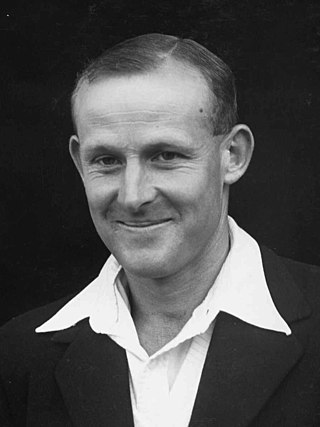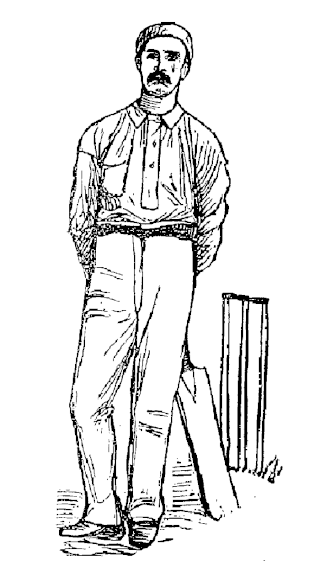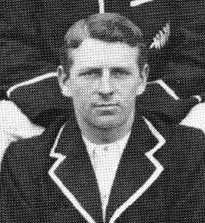Related Research Articles

William Maldon Woodfull was an Australian cricketer of the 1920s and 1930s. He captained both Victoria and Australia, and was best known for his dignified and moral conduct during the tumultuous bodyline series in 1932–33. Trained as a schoolteacher, Woodfull was known for his benevolent attitude towards his players, and his patience and defensive technique as an opening batsman. Woodfull was not a flamboyant player, but was known for his calm, unruffled style and his reliability in difficult situations. His opening pairing with fellow Victorian Bill Ponsford for both his state and Australia remains one of the most successful in history. While not known for his tactical skills, Woodfull was widely admired by his players and observers for his sportsmanship and ability to mould a successful and loyal team through the strength of his character.

Henry Butler Cave was a New Zealand cricketer who captained New Zealand in nine of his 19 Test matches. His Test career extended from 1949 to 1958, and he played first-class cricket from 1945 to 1959.

Archibald Jackson, occasionally known as Archibald Alexander Jackson, was an Australian international cricketer who played eight Test matches as a specialist batsman between 1929 and 1931. A teenage prodigy, he played first grade cricket at only 15 years of age and was selected for New South Wales at 17. In 1929, aged 19, Jackson made his Test debut against England, scoring 164 runs in the first innings to become the youngest player to score a Test century.

Frederick Theodore Badcock was a New Zealand first-class and Test cricketer. Perhaps the best all-rounder in New Zealand in the inter-war period, he played seven Test matches for New Zealand between 1930 and 1933, including New Zealand's inaugural Test in 1930. He was the first players capped by New Zealand.

The Fiji national cricket team is the men's team that represents Fiji in international cricket. Fiji has been an associate member of the International Cricket Council (ICC) since 1965, although the team's history goes back to the late 19th century.
This article describes the history of New Zealand cricket to 1890.

An English team raised by the Marylebone Cricket Club (MCC) toured New Zealand between December 1906 and March 1907. The tour comprised two first-class matches against New Zealand, two each against the four main provincial teams – Auckland, Canterbury, Otago and Wellington – and one against Hawke's Bay. There were also five minor matches against teams from country areas.

William Edward Barton was a New Zealand cricketer who played ten first-class matches for West Coast and Auckland in the 1880s. During his career he was widely considered to be the best batsman in New Zealand.
This article describes the history of Australian cricket from the 1918–19 season until 1930.
Ernest Henry Lovell "Bill" Bernau was a New Zealand cricketer who played first-class cricket from 1914–15 to 1927–28, and accompanied the New Zealand national cricket team on their tour of England in 1927.

An Australian team toured New Zealand and Fiji from February to April 1905 to play four first-class matches including two against New Zealand, which had not then attained Test status. Although it was the fifth Australian team to tour New Zealand, it was the first one to play matches on even terms, which therefore have first-class status. On previous tours all matches had been against teams of 15, 18 or 22 players. As well as the two matches against New Zealand, the Australians played first-class matches against Canterbury and Otago. The other games were non-first-class against Auckland, Wellington and Fiji.
The Australia national cricket team toured New Zealand from February to April 1914 and played eight first-class matches including two against the New Zealand national team. New Zealand at this time had not been elevated to Test status. The tour was organized and captained by Arthur Sims, who had previously represented New Zealand. The tour is notable for the fact that it featured Victor Trumper's final appearance in a first-class match before his death at age 37 in 1915.
An Australian cricket team toured New Zealand from February to April 1921 to play nine first-class matches including two against New Zealand. The Australians also played the main provincial teams.

Chester Arthur Holland was a New Zealand cricketer who played one match for New Zealand in the days before New Zealand played Test cricket.

Donald McKay Sandman was a cricketer who played first-class cricket for Canterbury from 1910 to 1927 and played several times for New Zealand in the days before New Zealand played Test cricket.
Thomas Richard Southall was an English-born New Zealand cricketer who played first-class cricket for Wellington from 1913 to 1915.

Raymond Leonard Alphonsus McNamee was an Australian cricketer who played first-class cricket for New South Wales from 1926 to 1929.
The Australian cricket team toured New Zealand in January and February 1881. The Australians played ten matches against provincial teams, nine of which fielded 22 players with the aim of providing more evenly-matched contests. Two further brief matches were played to fill the allotted time after a scheduled match finished early. As none of the matches were 11-a-side they are not considered to have been first-class.
The New Zealand Under-23 cricket team played 12 matches of first-class cricket in New Zealand between the 1962–63 season and the 1980–81 season.
The Whanganui cricket team represents the Whanganui District on the south-west coast of New Zealand's North Island. It also covers the adjoining areas of Rangitikei, Ruapehu and Waverley.
References
- ↑ "Australia in New Zealand 1928". CricketArchive. Retrieved 4 June 2014.
- ↑ Charlie Kelleway, "Introducing Ponsford, Kippax & Co.," New Zealand Truth , 2 February 1928, p. 1.
- ↑ "Cricket Board Meets". The Age: 7. 30 December 1927.
- ↑ "The Australian Team in New Zealand", The Cricketer , 5 May 1928, pp. 16–17.
- 1 2 "Cricket Welcome". Evening Post: 5. 15 February 1928.
- ↑ "Nelson, Marlborough and Westland v Australians 1927-28" . CricketArchive. Retrieved 14 April 2022.
- ↑ "Wellington v Australians 1927-28" . CricketArchive. Retrieved 14 April 2022.
- ↑ "North Otago v Australians 1927-28" . CricketArchive. Retrieved 16 April 2022.
- ↑ "Cricket: Australians at Oamaru". Press. 24 February 1928. p. 13.
- ↑ "Otago v Australians 1927-28". Cricinfo. Retrieved 16 April 2022.
- ↑ "Dickinson's Bowling Feat". Evening Star: 4. 25 February 1928.
- ↑ "Southland v Australians 1927-28" . CricketArchive. Retrieved 16 April 2022.
- ↑ "Canterbury v Australians 1927-28". Cricinfo. Retrieved 16 April 2022.
- ↑ "Waikato v Australians 1927-28" . CricketArchive. Retrieved 16 April 2022.
- ↑ "Auckland v Australians 1927-28". Cricinfo. Retrieved 16 April 2022.
- ↑ "Taranaki v Australians 1927-28" . CricketArchive. Retrieved 16 April 2022.
- ↑ "Wanganui v Australians 1927-28" . CricketArchive. Retrieved 16 April 2022.
- ↑ "Poverty Bay v Australians 1927-28" . CricketArchive. Retrieved 16 April 2022.
- ↑ "New Zealand v Australia 1927-28 (I)". Cricinfo. Retrieved 16 April 2022.
- 1 2 Don Neely & Richard Payne, Men in White: The History of New Zealand International Cricket, 1894–1985, Moa, Auckland, 1986, pp. 98–99.
- ↑ "New Zealand v Australia 1927-28 (II)". Cricinfo. Retrieved 16 April 2022.